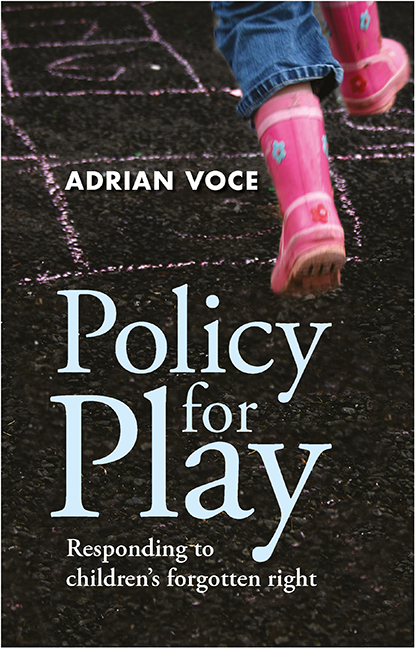Book contents
- Frontmatter
- Dedication
- Contents
- Who’s who
- About the author
- Preface
- Foreword
- Prologue
- Introduction ‘To respect, protect and fulfil’
- one ‘To play and to dream’ • Restoring play to the heart of the campaign for children’s rights
- two ‘For a change’ • Finding the evidence for play policy
- three ‘Advocates for play’ • Playwork’s place at the heart of the play movement
- four ‘New opportunities’ • Lottery funding and the beginnings of public play policy
- five ‘A vital and vibrant city’ • How devolved government in London set a benchmark for play policy
- six ‘Making the case’ • The call for a national play strategy
- seven ‘Things to do, places to go?’ • How play was overlooked by children’s services reform
- eight ‘Getting serious’ • The national play review
- nine ‘Lottery millions’ • The Children’s Play Initiative
- ten ‘Dirt is good’ • The Play England project
- eleven ‘The best place in the world’ • The Play Strategy for England
- twelve ‘Playbuilders’ • Breaking the mould of the public playground
- thirteen ‘Everyday adventures?’ • Austerity brings an end to play policy in England
- fourteen ‘Skylarks and canaries’ • The legacy of the Play Strategy
- fifteen ‘Children now’ • Responding to children’s right to play: conclusions and recommendations
- Epilogue
- References
- Index
seven - ‘Things to do, places to go?’ • How play was overlooked by children’s services reform
Published online by Cambridge University Press: 08 March 2022
- Frontmatter
- Dedication
- Contents
- Who’s who
- About the author
- Preface
- Foreword
- Prologue
- Introduction ‘To respect, protect and fulfil’
- one ‘To play and to dream’ • Restoring play to the heart of the campaign for children’s rights
- two ‘For a change’ • Finding the evidence for play policy
- three ‘Advocates for play’ • Playwork’s place at the heart of the play movement
- four ‘New opportunities’ • Lottery funding and the beginnings of public play policy
- five ‘A vital and vibrant city’ • How devolved government in London set a benchmark for play policy
- six ‘Making the case’ • The call for a national play strategy
- seven ‘Things to do, places to go?’ • How play was overlooked by children’s services reform
- eight ‘Getting serious’ • The national play review
- nine ‘Lottery millions’ • The Children’s Play Initiative
- ten ‘Dirt is good’ • The Play England project
- eleven ‘The best place in the world’ • The Play Strategy for England
- twelve ‘Playbuilders’ • Breaking the mould of the public playground
- thirteen ‘Everyday adventures?’ • Austerity brings an end to play policy in England
- fourteen ‘Skylarks and canaries’ • The legacy of the Play Strategy
- fifteen ‘Children now’ • Responding to children’s right to play: conclusions and recommendations
- Epilogue
- References
- Index
Summary
Margaret Thatcher’s Conservative administration of the 1980s, which had seen mass unemployment result from the restructuring of Britain’s industrial economy, refused to concede that poverty existed in Britain. But while there was no official recognition and therefore no accepted definition of it during those years, academic research (Piachaud and Sutherland, 2001) showed that, by the most widely recognised measure (living below half of the mean level of income after housing costs), ‘over the course of Conservative governments from 1979 to 1997 the number of children in poverty tripled’ to 4.5 million: one in three of the child population. With the advent of the New Labour government of 1997, poverty – and child poverty in particular – became a major policy theme and, in March 1999, Prime Minister Tony Blair announced that ‘our historic aim [is] to be the first generation to end child poverty […] It is a 20 year mission’ (White, 1999).
As we have seen, before the election that brought him to power, Blair had identified ‘education, education, education’ (Adonis, 2012) as his ‘three’ top priorities. However, while raising academic attainment may have been the Prime Minister’s most favoured means for achieving his hugely ambitious goal on child poverty, there was a strong push from his influential Chancellor, Gordon Brown, to look at other causes of poverty and what else the government could do to alleviate them. The Chancellor was particularly interested in how economic inequality led to social exclusion, and what could be done for children who were at risk from it. His big initiative on this front was the Children’s Fund, a national programme of investment in preventative, or ‘upstream’, projects and services ‘over and above those provided through mainstream statutory funding’ (Edwards et al, 2006). The initiative aimed to ‘provide support for young people and their families before they reach crisis, while reducing the future probability of poor outcomes, and maximising life chances’. It was funded directly by the Treasury via an innovative cross-departmental Children and Young People’s Unit (CYPU) to the projected tune of £780 million from 2001–8.
The Children’s Fund redefined ‘children in need’ to include those ‘at risk of social exclusion’ and was specifically designed to ‘engage and support voluntary and community organisations in playing an active part [in working] together to help children overcome poverty and disadvantage’ (CYPU, cited in Morris et al, 2009).
- Type
- Chapter
- Information
- Policy for PlayResponding to Children's Forgotten Right, pp. 71 - 82Publisher: Bristol University PressPrint publication year: 2015



